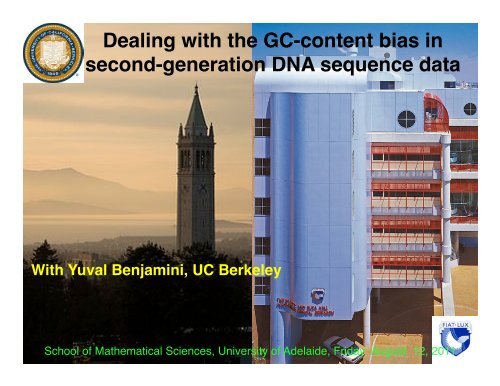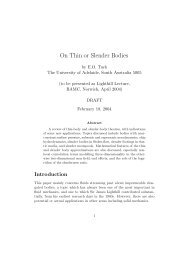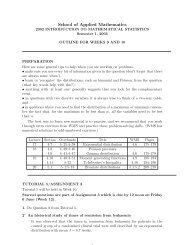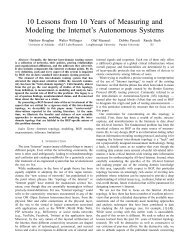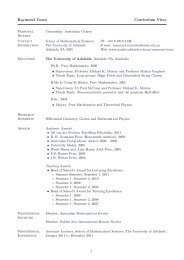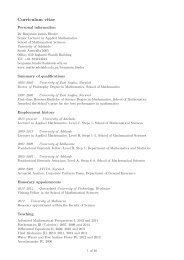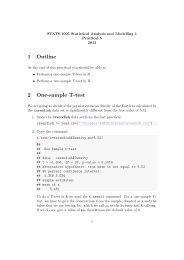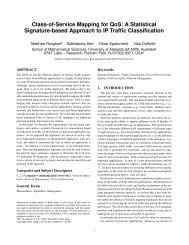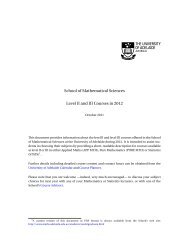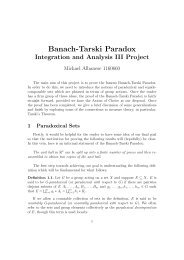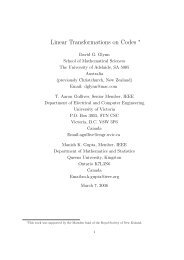Slides of his talk - School of Mathematical Sciences - University of ...
Slides of his talk - School of Mathematical Sciences - University of ...
Slides of his talk - School of Mathematical Sciences - University of ...
You also want an ePaper? Increase the reach of your titles
YUMPU automatically turns print PDFs into web optimized ePapers that Google loves.
Dealing with the GC-content bias in<br />
second-generation DNA sequence data!<br />
Margaret Taub!<br />
Yuval Benjamini!<br />
Oleg Mayba!<br />
Sandrine Dudoit!<br />
Kasper Hansen!<br />
Jim Bullard!<br />
Steffen Elizabeth Durinck! Purdom!<br />
Gary Schroth!<br />
With Yuval Benjamini, UC Berkeley!<br />
1<br />
<strong>School</strong> <strong>of</strong> <strong>Mathematical</strong> <strong>Sciences</strong>, <strong>University</strong> <strong>of</strong> Adelaide, Friday August 12, 2011!
GC matters!<br />
2
First, note base pairing:!<br />
A with T, C with G!<br />
G with C, T with A!<br />
3
Three hydrogen bonds!<br />
4
Two hydrogen bonds!<br />
5
GC content here = 2/4 = 50%!<br />
6
GC content here 445/1000!<br />
8
An illustration <strong>of</strong> the spatial distribution <strong>of</strong> GC content <strong>of</strong><br />
non-overlapping 1,024-bp windows along a fragment,<br />
approximately 1.4 Mb in length, from human chromosome 19<br />
Cohen N et al. Mol Biol Evol 2005;22:1260-1272<br />
© The Author 2005. Published by Oxford <strong>University</strong> Press on behalf <strong>of</strong> the Society for Molecular<br />
Biology and Evolution. All rights reserved. For permissions, please e-mail:<br />
journals.permissions@oupjournals.org<br />
9
Ability to !<br />
denature!<br />
All depend on!<br />
GC content!<br />
Ability <strong>of</strong><br />
primers<br />
to anneal!<br />
Rate and<br />
fidelity <strong>of</strong><br />
extension<br />
reaction<br />
aa<br />
10
Illumina short-read DNA sequencing!<br />
11
Illumina Sequencing Technology <br />
3’<br />
5’<br />
DNA<br />
(0.1-1.0 ug)<br />
Sample preparation<br />
usually involves PCR<br />
and size selection<br />
Single Cluster molecule growth array<br />
1 2 3 4 5 6 7 8 9<br />
A<br />
C<br />
T<br />
C<br />
T<br />
G<br />
C<br />
T<br />
G<br />
A<br />
A<br />
G<br />
5’<br />
T<br />
G<br />
C<br />
T<br />
A<br />
C<br />
G<br />
A<br />
T<br />
A<br />
C<br />
C<br />
C<br />
G<br />
A<br />
T<br />
C<br />
G<br />
A<br />
T<br />
Sequencing<br />
T G C T A C G A T …<br />
Image acquisition<br />
Base calling<br />
Slide courtesy <strong>of</strong> G Schroth, Illumina 12
35+ bp reads!<br />
Reads mapped to the reference genome!<br />
13
Our original motivation: <br />
DNA copy number estimation!<br />
• Amplifications and losses occur in most genomes, relative to a<br />
reference, especially in tumor genomes, which are our focus.!<br />
• These can be seen at different scales, from one or a few basepairs<br />
to entire chromosomes (in cases <strong>of</strong> aneuploidy).!<br />
• We would like to measure (count) the number <strong>of</strong> times a region<br />
appears in a genome using DNA-seq data on that genome,<br />
ideally without using reference or matched normal data.!<br />
14
24 color!<br />
karyotypes!<br />
<strong>of</strong> 6 breast!<br />
cancer cell!<br />
lines!<br />
Davidson et al<br />
BrJCa, 2000<br />
15
Counts are normalized in 20 kb bins with GC-dependent weights. !<br />
Then each chromosome is compared to all others using counts<br />
from normalized 50 kb bins and forming z-statistics. !<br />
From Fig 3 <strong>of</strong> Fan & Quail, PLoS One 2010 !<br />
17
Our story proper begins here!<br />
18
GC content biases first noted!<br />
They used Illumina 1G data.!<br />
19
From Dohm et al 2008 !<br />
Roughly linear GC effect on reads!<br />
Reads per kb!<br />
Reads per kb!<br />
GC content!<br />
GC content!<br />
0.2 0.45 0.2<br />
0.45<br />
Beta Vulgaris 1kb bins<br />
Helicobacter 1kb bins<br />
20
Another view: a human data set!<br />
• Position <strong>of</strong> reads on forward strand <strong>of</strong> chr 2!<br />
• Binned to 10 kb intervals!<br />
21
The GC bias is non-linear in human data <br />
(5 kb bins below, but it looks similar for all bin sizes)!<br />
Data – M. Robinson Data – D. Chiang Data – P. Spellman<br />
Horizontal axis: fraction GC; lines are loess curves in all cases!<br />
22
Our goals!<br />
• To study the nature <strong>of</strong> the GC content effect!<br />
• Find how best to correct for it!<br />
• Try to understand relation between the effect<br />
and study design, i.e. its causes!<br />
• Perhaps identify designs that minimize it.!<br />
Analyzing and minimizing PCR amplification bias in Illumina<br />
sequencing libraries. Aird D, Ross MG, Chen WS, Danielsson M,<br />
Fennell T, Russ C, Jaffe DB, Nusbaum C, Gnirke A. Genome<br />
Biol. 2011 Feb 21;12(2):R18.!<br />
Systematic bias in high-throughput sequencing data and its<br />
correction by BEADS. Cheung MS, Down TA, Latorre I, Ahringer J.<br />
Nucleic Acids Res. 2011 Jun 6. [Epub ahead <strong>of</strong> print]!<br />
23
Our goal today!<br />
• To study the nature <strong>of</strong> the GC content effect!<br />
• Find how best to correct for it!<br />
24
Digression: mappability!<br />
• Some % <strong>of</strong> reads not mapped due to ambiguity<br />
(depends on read length & mapping criteria)!<br />
• Mappability = the probability that a read<br />
beginning in region can be successfully mapped.!<br />
• Can take a simple 0-1 approach (as here), and<br />
bin.!<br />
Count<br />
proportion mappable<br />
25
Our data!<br />
Two samples <strong>of</strong> DNA from an ovarian patient: one sample<br />
from the tumor, the other matched normal from their white<br />
blood cells. !<br />
Each sample was turned into two separate fragment libraries,<br />
differing in fragment length distribution. !<br />
Fragments were sequenced to 75bp at both ends using the<br />
standard Illumina procedure.!<br />
Each sequenced read pair was mapped back to the human<br />
reference genome using bwa (version0.4.9). [A few more<br />
details are omitted here.] !<br />
26
Most <strong>of</strong> the time we present results <br />
for just one chromosome!<br />
But it doesnʼt matter….!<br />
27
GC loess curves for <br />
chromosomes 1-5, 10kb bins !<br />
Estimated fragment count!<br />
Counts for!<br />
library 1 !<br />
scaled to !<br />
match those!<br />
for library 2!<br />
Fraction GC!<br />
28
Is the GC-bias specific to a lab, protocol, sample,<br />
library preparation, sequencing machine,….? !<br />
E.g. can we adjust binned tumor counts by those <strong>of</strong> a<br />
matched normal sample, or, in a Chip-seq experiment,<br />
IP-counts by input <strong>of</strong> other control counts?!<br />
29
Figure 2: GC curves (10 kb bins). Observed fragment counts and loess lines plotted against<br />
GC <strong>of</strong> (A) Conclusion: two libraries from the the same effect normal seems sample, and largely (B) the to tumor be library run (red) specific. with its<br />
matched normal sample library (blue). Counts and curves <strong>of</strong> all libraries are scaled to fit median<br />
counts <strong>of</strong> normal library 1. Bins were randomly sampled from chromosome 1, and counts include<br />
fragments from both strands.
Is there a right bin size? <br />
People have used 100bp, 5 kb, 10 kb, 20 kb, 100 kb.!<br />
31
Variation about loess curve for <br />
different bin sizes!<br />
Loess bin size (kb) 10 5 2 1 0.5 0.2<br />
Library 1 (MAD) 49.1 47.8 45.1 43.4 43.4 52.2<br />
Library 2 (MAD) 26.0 24.7 22.5 21.7 23.6 41.6<br />
32
Avoiding binning: single position analyses <br />
(also done by Cheung et al, 2011) <br />
We work with a random sample <strong>of</strong> ~10M mappable locations<br />
on the genome locations denoted by x. All paired end,<br />
and forward strand, unless otherwise stated. !<br />
The fragment count at location x may depend on the GC<br />
content <strong>of</strong> the window W a,l = [x+a, x+a+l), which we will<br />
denote by gc = GC(x+a,l).!<br />
33
Here the window begins at the base <strong>of</strong> interest. It need not do so.!<br />
34
Whatʼs interesting about these <br />
read rate vs GC-content curves <br />
as we vary window size and location?!<br />
Superficially: their shape, that is, their deviation<br />
from flatness, which is GC-independence. !<br />
More interestingly, their ability to help explain<br />
variation in read depth. We return to t<strong>his</strong> later.!<br />
Letʼs keep it superficial for now, and measure<br />
deviation from flatness.!<br />
35
Total variation distance from GC independence. <br />
A surrogate measure <strong>of</strong> how much is explained by conditioning<br />
on GC.<br />
Read rate!<br />
TV distance = a weighted average <strong>of</strong> the brown lengths!<br />
36
In symbols, !<br />
ˆ " = F gc<br />
,<br />
gc<br />
N gc<br />
" ˆ = F n<br />
N gc<br />
TV(W a,l<br />
) = 1<br />
l<br />
2 ˆ # | ˆ "<br />
" n<br />
gc<br />
$ ˆ " |,<br />
gc =0<br />
!<br />
where W a,l<br />
is the window [x + a, x + a + l).<br />
!<br />
Next we look at some TV values. We can vary a<br />
and l, and we do so, separately here, for simplicity !<br />
37
Varying the window size from a fixed point <br />
(here the 5ʼ-end <strong>of</strong> the fragment)!<br />
Figure 3: Single position models. (A) The top curves represent TV scores for GC windows <strong>of</strong><br />
different lengths, all beginning at 0 (a=0). The bars on the bottom mark the median fragment<br />
lengths (and 0.05, 0.95 quantiles). For each library, the strongest GC windows are those that<br />
encompass the full fragment. For library 1, we mark the optimal model (W 0,180 ), and show its
Varying the window size from a fixed point <br />
(here the 5ʼ-end <strong>of</strong> the fragment)!<br />
Figure 3: Single position models. (A) The top curves represent TV scores for GC windows <strong>of</strong><br />
different lengths, all beginning at 0 (a=0). The bars on the bottom mark the median fragment<br />
lengths (and 0.05, 0.95 quantiles). For each library, the strongest GC windows are those that<br />
encompass the full fragment. For library 1, we mark the optimal model (W 0,180 ), and show its
Varying the location <strong>of</strong> a fixed size window <br />
(here 50 bp; library 1)!<br />
Figure 4: Different lags (A) GC curve <strong>of</strong> the window before the fragment - W −50,50 , (B) within<br />
the read - W 0,50 , and (C) in the fragment center, not overlapping the read - W 75,50 . (D) A plot
Interim conclusion from many such plots!<br />
The “best” interval is in the middle <strong>of</strong> the fragment,<br />
excluding the bits at the very ends (see later).!<br />
Next steps: dealing with both strands, and fragment size.!<br />
41
Forward and reverse strands behave similarly!<br />
Figure 16: [[Supp Materials]] GC effect on the strands. (A) TV Score <strong>of</strong> 50 bp GC<br />
windows, based on forward strand fragments(blue, same as Figure 4, (D)) and reverse strand<br />
fragments (black, dot-dash). The dashed line marks the TV scores <strong>of</strong> the reverse strand after<br />
proper inversion (dashed line). (B) Fragment GC curve estimated from each <strong>of</strong> the strands
Forward and reverse strands behave similarly!<br />
Figure 16: [[Supp Materials]] GC effect on the strands. (A) TV Score <strong>of</strong> 50 bp GC<br />
windows, based on forward strand fragments(blue, same as Figure 4, (D)) and reverse strand<br />
fragments (black, dot-dash). The dashed line marks the TV scores <strong>of</strong> the reverse strand after<br />
proper inversion (dashed line). (B) Fragment GC curve estimated from each <strong>of</strong> the strands
Stratifying by fragment size s!<br />
ˆ "<br />
s<br />
gc<br />
= F s<br />
gc<br />
N<br />
s<br />
gc<br />
!<br />
44
Fragment size matters <br />
Rates by fragment length and GC!<br />
Single length GC curves!<br />
Fragment length!<br />
GC count in fragment!<br />
GC fraction!<br />
Figure 5: Fragment rate by length and GC. (A) A heat map describes rates for each (GC,<br />
length) pair. Each dotted line represents a single length. In (B), GC curves for fragments <strong>of</strong><br />
Conclusion: GC bias <strong>of</strong> not simply determined by the<br />
specific lengths are drawn (corresponding to the dotted lines in (A)). Blue / dark curves represent<br />
longer fragments than red / bright. Here x-axis is the fraction <strong>of</strong> GC. All fragment length models<br />
here have a margin <strong>of</strong> 2 from both fragment ends (a = 2, m = 2).<br />
ratio GC count/fragment length: there is an interaction.
And now for some predictions!<br />
46
Predicted rates at a given mappable position!<br />
$<br />
s<br />
ˆ µ = c ˆ "<br />
s<br />
x GC(x +a, s#m)<br />
$<br />
x %B<br />
ˆ µ = ˆ µ B x<br />
Here c is a scaling constant to equalize the predicted and the<br />
observed median. From now on, our window is the fragment !<br />
minus 2 bp at each end, i.e. a=2, l=s-2. !<br />
!<br />
47
Predicted and observed bin <br />
counts for bins <strong>of</strong> different sizes!<br />
10kb 10K bp<br />
1kb 1K bp<br />
200bp!<br />
Counts<br />
0 200 400 600 800 1000<br />
Counts<br />
0 20 40 60 80 100 120<br />
Counts<br />
0 5 10 15 20 25 30<br />
0.3 0.4 0.5 0.6<br />
%GC in bin<br />
0.3 0.4 0.5 0.6 0.7 0.8<br />
%GC in bin<br />
0.2 0.4 0.6 0.8<br />
%GC in bin<br />
Lowess lines are based on the observed points. !<br />
Conclusion: the predictions seem to be working.!<br />
48
Some other biases/models!<br />
49
Breakpoint effects!<br />
0.25 0.27 0.29 0.31<br />
A<br />
GG<br />
CG<br />
TG<br />
AG<br />
Fragment rate by dinucleotide at breakpoint<br />
0.25 0.27 0.29 0.31<br />
0.19 0.21 0.23 0.25<br />
−50 0 50 100 150 200<br />
T<br />
rang<br />
−50 0 50 100 150 200<br />
C<br />
rang<br />
GC<br />
CC<br />
TC<br />
AC<br />
GT<br />
CT<br />
TT<br />
AT<br />
GA<br />
CA<br />
TA<br />
AA<br />
0.19 0.21 0.23 0.25<br />
−50 0 50 100 150 200<br />
G<br />
rang<br />
0.00 0.02 0.04 0.06 0.08 0.10<br />
−50 0 50 100 150 200<br />
Breakpoint model: uses GC(x-2,x+4)!<br />
50
End effects!<br />
GC before fragment<br />
GC overlaps read<br />
GC at fragment center<br />
Fragment Rate<br />
0.00 0.05 0.10 0.15<br />
A<br />
L1 = 0.12<br />
Fragment Rate<br />
0.00 0.05 0.10 0.15<br />
B<br />
L1 = 0.20<br />
Fragment Rate<br />
0.00 0.05 0.10 0.15<br />
C<br />
L1 = 0.29<br />
0.0 0.2 0.4 0.6 0.8 1.0<br />
0.0 0.2 0.4 0.6 0.8 1.0<br />
0.0 0.2 0.4 0.6 0.8 1.0<br />
0.25 0.30<br />
GC<br />
GC<br />
GC<br />
Slight AT preference!<br />
L1 Scores, stratified by GC windows <strong>of</strong> 50 bp<br />
D Two ends model: uses GC(x,l)+GC(x+s-l,l). !<br />
We use s=180, l=30 below.!<br />
51
200 400 600 800<br />
Counts<br />
0 20 40 60 80<br />
Some other predictions <br />
(all aggregated to 1kb bins)!<br />
Counts<br />
0 5 10 15 20<br />
Read model!<br />
0.2 0.3 0.4 0.5 0.6 0.7<br />
Read model (1 kb)<br />
GC <strong>of</strong> bin<br />
Two-end model!<br />
0.2 0.3 0.4 0.5 0.6 0.7 0.8<br />
2−side model (1 kb)<br />
GC <strong>of</strong> bin<br />
Fragmentation model!<br />
0.2 0.3 0.4 0.5 0.6 0.7 0.8<br />
Fragmentation model (1 kb)<br />
GC <strong>of</strong> bin<br />
0 20 40 60 80 100 120<br />
D<br />
Counts<br />
0 20 40 60 80 100 120<br />
E<br />
Counts<br />
0 20 40 60 80 100 120<br />
F<br />
0.2 0.3 0.4 0.5 0.6 0.7 0.8<br />
0.2 0.3 0.4 0.5 0.6 0.7 0.8<br />
0.2 0.3 0.4 0.5 0.6 0.7 0.8<br />
Fraction GC in all cases!<br />
Conclusion: These predictions don’t work too well.<br />
52
How well does our correction work?!<br />
Theory!<br />
53
Spread <strong>of</strong> observed counts around predictions!<br />
Spread <strong>of</strong> observed counts around prediction (1 kb bins)<br />
Observed Counts<br />
0 20 40 60 80 100 120<br />
Quantiles 0.1 and 0.9<br />
Mappability Only<br />
Loess<br />
Fragment<br />
Poisson Dist<br />
Mean−line<br />
1kb bins<br />
0 20 40 60 80 100<br />
Predicted Counts<br />
Conclusion: we don’t “explain” everything.<br />
54
How well does our correction work?!<br />
Practice!<br />
55
Copy number: corrections to normal samples!<br />
Slight improvement<br />
over loess.<br />
Figure 8: Corrected counts <strong>of</strong> normal sample. (A) Counts in 1 kb bins not corrected for GC<br />
(top), corrected by loess (center), and corrected by fragment model (bottom), positions 7,000-
Copy number: crude corrections to<br />
tumor samples!<br />
More work to be<br />
done here.<br />
Figure 9: Copy number (CN) gain from tumor sample Counts and corrected counts at<br />
position 29,000 kb on chromosome 2. (A) Unnormalized counts at 1 kb bins (top), corrected by
Summary!<br />
We seem to have ruled out GC-content <strong>of</strong> the read parts <strong>of</strong> the<br />
fragment as producing the GC bias. !<br />
Similarly we seem to have ruled out GC content on a scale more<br />
“global” than just the fragment.!<br />
Base composition (not just GC-content) around the two fragment<br />
break points plays a noticeable role, but not enough to explain<br />
everything.!<br />
Speculation over causes is left for another day. There now<br />
seems little doubt that PCR amplification bias accounts for the<br />
majority, as shown in a beautiful recent paper by D. Aird et al<br />
(2011) in the Feb 21 issue <strong>of</strong> Genome Biology. !<br />
58
Many thanks to!<br />
• Yuval Benjamini!<br />
• Oleg Mayba, Pierre Neuvial, Henrik Bengtsson,<br />
and Su Yeon Kim!<br />
• Paul Spellman and Mark Robinson for data!<br />
• Leath Tonkin for discussions on the bias!<br />
• The whole Berkeley NGS group!<br />
And to you…!<br />
59
ChIP-seq data (A. thaliana) <br />
Here two initially incompatible technical replicates!<br />
Uncorrected ratios GC curves (a=2, l=122) Corrected ratios<br />
1kb bins<br />
1kb bins<br />
GC GC GC<br />
Figure 14: [[Supp Materials]] Coverage ratios between two ChIP-seq techinical replicates.<br />
(A) Uncorrected count ratios (R1 count/ R2 count) by GC; (B) GC curves <strong>of</strong> Replicate<br />
1 (blue) andProblem Replicate 2 (magenta); mainly (C) solved Ratios <strong>of</strong> corrected (cf Cheung counts. Binet counts al, are 2011) from both<br />
strands, based on sample <strong>of</strong> chromosome 1 bins. Replicate 2 GC curve was adjusted to match<br />
total fragments in Replicate 1.
Other examples and phenomena <br />
(if time)!<br />
62
Plots for a BrCa tumor!<br />
Figure 12: GC plots for Dataset 2. (A) GC effect for 10 kb (chromosome 1). (B) TV scores for<br />
GC windows <strong>of</strong> different lengths with a=0 (comparable to Figure 3). (C) GC curve at fragment
Plots for ChIP-seq sample rep 1, A. thaliana!<br />
fragment model (from TV scores, see (B)), we can see traces <strong>of</strong> unimodality in the GC effect<br />
(C). Correction based on t<strong>his</strong> model removes the GC effect in the binned data (D).<br />
Figure 13: [[Supp Materials]] GC plots for ChIP-seq sample (replicate 1). (A) GC<br />
effect for 10 kb bins. (B) TV scores for GC windows <strong>of</strong> different lengths with a=0. (C) GC curve<br />
at fragment model with 2 bp margin (W 2,122 ), the optimal model from (B). (D) Observed (blue)<br />
and predicted (black) counts against GC for 1 kb bins (both strands)
Plots for one 1,000 genomes sample!<br />
Figure 18: [[Supp Materials]] GC plots for HG00262 sample. (A) GC effect for 10 kb.<br />
(B) TV scores for GC windows <strong>of</strong> different lengths with a=0 (comparable to Figure 3). (C) GC
the fragments based on their GC, and show the absolute (A) and relative (B) abundance <strong>of</strong> the<br />
two quality groups. Low mapping (black) quality fragments are a much larger portion <strong>of</strong> high GC<br />
fragments, and are very rare in high AT fragments. In fact, almost all high-GC fragments that are<br />
mapped are <strong>of</strong> low quality. T<strong>his</strong> is perhaps an indication <strong>of</strong> problems with sequencing fragments<br />
with very high GC fragments. Surprisingly, t<strong>his</strong> difference in GC composition is stronger for the<br />
GC <strong>of</strong> theFragments full fragments than that<br />
partitioned<br />
<strong>of</strong> the reads (not shown).<br />
by quality score!<br />
Figure 11: Fragments partitioned by quality score. (A) Number <strong>of</strong> low quality (dark grey)<br />
and high quality (light grey) fragments mapping to sampled locations, for each GC category. (B)


